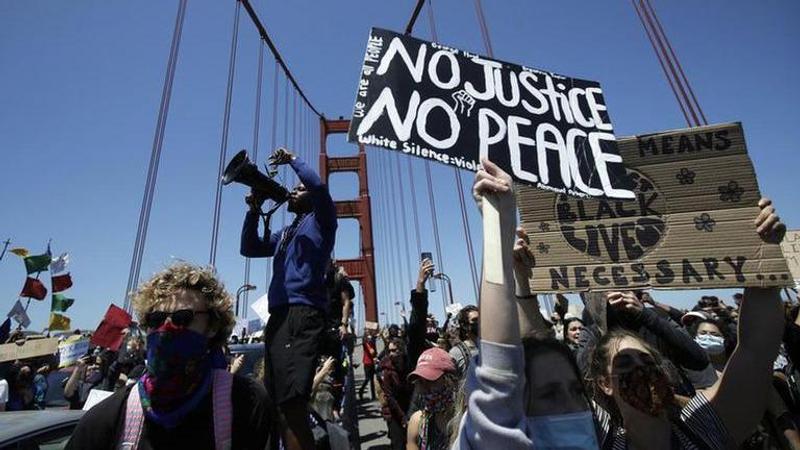Published 10:40 IST, June 7th 2020
Protesters flood streets in huge, peaceful push for change
Massive demonstrations against racism and police brutality filled some of the nation's most famous cityscapes, with tens of thousands of people marching peacefully in scenes that were more often festive than tense.

Washington, Jun 7 (AP) Massive demonstrations against racism and police brutality filled some of the nation's most famous cityscapes, with tens of thousands of people marching peacefully in scenes that were more often festive than tense.
Wearing masks and urging police reform, protesters on Saturday gathered in dozens of places from coast to coast, while mourners in North Carolina waited for hours to glimpse the golden coffin carrying the body of native son George Floyd, a black man whose death at the hands of Minneapolis police has galvanised the expanding movement.
Collectively, it was perhaps the largest one-day mobilisation since Floyd died 12 days ago and came as many cities began lifting curfews that authorities imposed following initial spasms of arson, assaults and smash-and-grab raids on businesses. Authorities have softened restrictions as the number of arrests plummeted.
Demonstrations also reached four other continents, ending in clashes in two European cities.
The largest US demonstration appeared to be in Washington, where streams of protesters flooded streets that were closed to traffic.
On a hot, humid day, protesters gathered at the Capitol, on the National Mall and in neighbourhoods.
Some turned intersections into dance floors. Tents offered snacks and water. On one block, the chime of an ice cream truck competed with the rumble of a helicopter overhead.
Pamela Reynolds said she came seeking greater accountability for police.
“The laws are protecting them,” said the 37-year-old African American teacher. Among the changes she wants is a federal ban on police chokeholds and a requirement for officers to wear body cameras.
Many groups headed toward the White House, which was fortified with new fencing and extra security measures.
Inside the presidential mansion, their chants and cheers could be heard in waves. President Donald Trump, who has urged authorities to crack down on unrest, had no public events.
The demonstrations extended to Trump's golf resort just outside Miami, where about 100 protesters gathered.
Elsewhere, the backdrops included some of the nation's most famous landmarks.
Peaceful marchers filed across the Golden Gate Bridge in San Francisco and the Brooklyn Bridge in New York.
They walked the boulevards of Hollywood and the street in downtown Nashville, Tennessee, famous for country music-themed bars and restaurants.
Many wore masks — a reminder of the danger that the protests could exacerbate the spread of the coronavirus.
Roderick Sweeney, who is black, said he was overwhelmed to see the large turnout of white protesters waving signs that said “Black Lives Matter” as hundreds gathered near the Golden Gate Bridge.
“We've had discussions in our family and among friends that nothing is going to change until our white brothers and sisters voice their opinion,” said Sweeney, 49.
The large turnout of white protesters “is sending a powerful message.” In Philadelphia and Chicago, marchers chanted, carried signs and occasionally knelt in silence. Protesters flooded the streets in a massive showing near the Philadelphia Museum of Art and its famous “Rocky” steps, chanting “No justice, no peace!” before setting off for City Hall.
A large crowd of medical workers — many in lab coats and scrubs — marched to Seattle's City Hall. Signs they held read, “Nurses kneel with you, not on you” and “Police violence and racism are a public health emergency.”
Atop a parking garage in downtown Atlanta, a group of black college band alumni serenaded protesters with a tuba-heavy mix of tunes. Standing within earshot, business owner Leah Aforkor Quaye said it was her first time hitting the streets.
“This makes people so uncomfortable, but the only way things are happening is if we make people uncomfortable,” said Quaye, who is black.
In Raeford, North Carolina, a small town near Floyd's birthplace, people lined up outside a Free Will Baptist church, waiting to enter in small groups. At a private memorial service, mourners sang along with a choir. At the front of the chapel was a large photo of Floyd and a portrait of him adorned with an angel's wings and halo.
“It could have been me. It could have been my brother, my father, any of my friends who are black,” said Erik Carlos of nearby Fayetteville. “It made me feel very vulnerable at first.”
Protesters and their supporters in public office say they're determined to turn the extraordinary outpouring into change, notably overhauling policing policies. In Washington, Minneapolis and elsewhere, marchers urged officials to “defund” police — a demand that has become more common in recent days.
Theresa Bland, 68, a retired teacher and real estate agent protesting at the Ohio Statehouse in Columbus, had a broader agenda in mind.
“I'm looking at affordable housing, political justice, prison reform, the whole ball of wax,” she said.
Some reforms already have been enacted.
Minneapolis officials have agreed to ban chokeholds and neck restraints by police and to require officers to stop other officers using improper force.
California Gov. Gavin Newsom ordered the state's police-training program to stop teaching officers a neck hold that blocks the flow of blood to the brain.
The police chief in Bellevue, a wealthy city near Seattle, largely banned officers from using neck restraints, while police in Reno, Nevada, updated their use-of-force policy.(AP) RUP
Updated 10:40 IST, June 7th 2020




